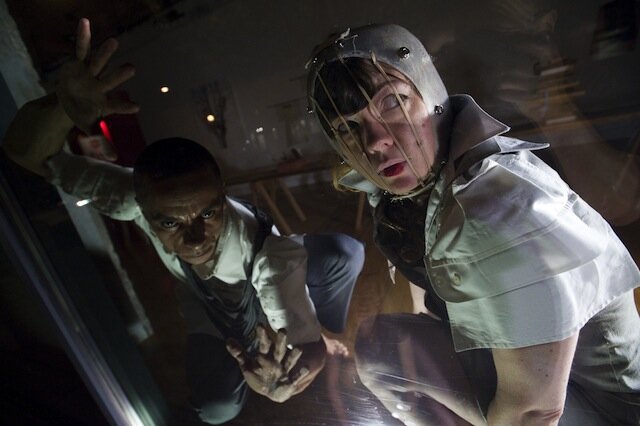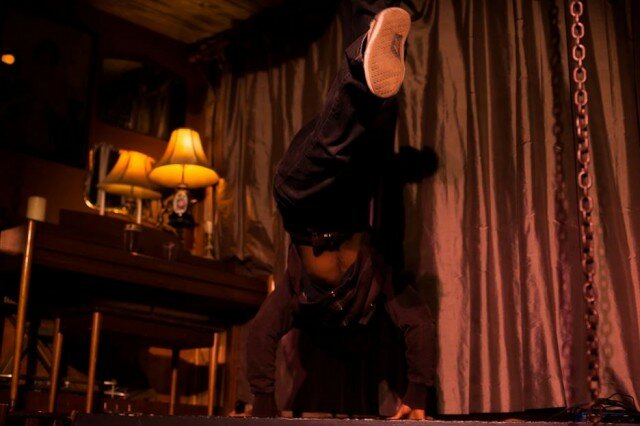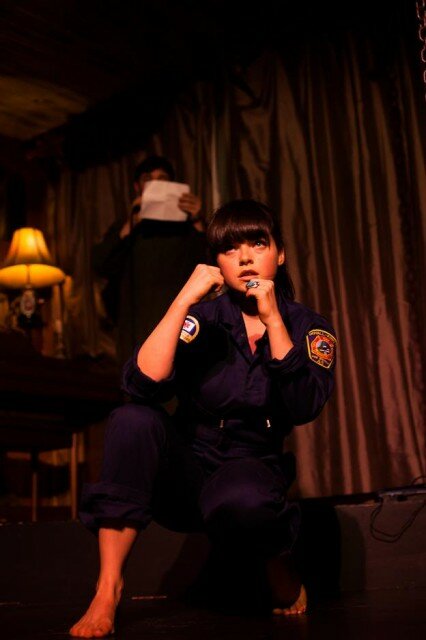
Seattle’s modern dance explosion has tendrils reaching all over the city these days, outside the usual dance venue suspects. This October Paige Barnes is presenting her “media exhibition” LEAD BUNNY at the Hedreen Gallery, which is the art gallery attached to Seattle University’s Lee Center on 12th Avenue. The exhibit runs through October 31, 2012, but the dance performances are this weekend, through October 14.
The modern dance performance is interrupted by short animations featuring “lead bunnies” (big-eared sketch-bunnies that fill up with lead, and then leak it into their surroundings), created by animator Stefan Gruber and sound composer Rosten Woo. This is supposed to provide an emotional subtext, though I am unsure about how well that works; the animation has a distinct feel, but I don’t think you’d describe it as leaden without prompting. Its relationship to Barnes’s choreography is provided more directly through the fact of its juxtaposition.
About her work, Barnes says, “I see a lone wolf pup howling juxtaposed with the most complicated and layered human relationships,” and as strange as that sounds, you can pick that up from her choreography (and Jme Frank’s sci-fi-meets-aborigine costumes with masks by Ret Harrison). The piece opens with Vincent Cuny and Pol Rosenthal sitting in chairs across from each other, when Cuny (I believe) makes a startling chest-slapping move that comes to seem like a territorial signal–the two end up wrestling, shoving, carrying one over the other’s shoulder.
They’re joined by Barnes, Alice Gosti, Paris Hurley, and Nadia Losonsky. Gosti I believe enters throwing a chair, repeatedly, the length of the space, like a grumpy poltergeist. (I keep saying “I believe” because the masks cover faces, and the lighting is shadowy.) Two other dancers discuss, in French, dancing in front people (“devant les gens”). The rest of the evening is largely a working out of those complications and layers that Barnes mentioned, punctuated to moody effect by Paris Hurley and Bob Barraza’s compositions, and found-sound recordings by Julian Martlew and Barnes herself.
Occasionally the group finds a harmony that’s expressed in unison, but there are also moments when the pack surrounds a single dancer, growling menacingly, or drags one across the floor. The idiom, as befits a show with this name, is sometimes heavy-footed (at one point, the troupe dons hip waders), and there’s a good deal of floor work (so make sure your seat gives a good sightline).
Just as I was beginning to want to see something with a cleaner line, Cuny got a solo that was a study in both his musculature and precision of movement. It’s a very intense close–Cuny’s expression is almost unbearably yearning. In threading one arm through the triangle formed by the bend in his other arm, he creates a new body.
Modern Dance Behind the Pink Door
Alice Gosti, the Spaghetti Co. founder, is the the curator and organizer of a series called “Modern Dance Behind the Pink Door“–on October 5, it made its tenth appearance in the lounge at the Pink Door in Post Alley.
Except for Gosti’s curation, the format is something like a late-night open mic night for dance, in terms of a catholic taste that presented a musical performance by Thunderpussy, an homage to Chaplin’s movement style for The Tramp, the space-age girl group of Stilaan (Rosa Vissers’ choreography), and an auto-tuned ode to pre-flight safety instructions called “Breathe Normally.” Markeith Wiley began his performance out on the floor, shaking a can with change and he wended his way through the audience, playing with people’s concerns about panhandling (and/or perceptions of dance’s worth), then shutting people up with his moves once he gained the stage.
With twelve short performances, it was a chance to see a lot of choreographic talent without the hindrances that come with more formal settings. It’s very quick, so sometimes you get just a glimpse of an idea forming, rather than its development and extension. But there’s an engagement from the crowd packed into the Pink Door lounge (if there were rafters, it would have been packed up there) that you don’t often see when it comes to modern dance. Chairs are gathered in the center of the room, with tables pushed around. (A wooden pillar bisects the stage, so try to get well to one side of that.) You feel like you’ve stumbled upon that secret party you never knew existed.





